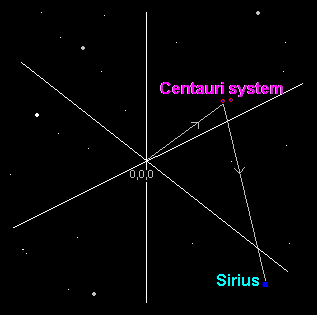
If you start thinking in hundreds of light years, and the star
is moving, say just 20 miles a second, in relation to us, well, after a
several hundred years, it's no longer where it was. In fact, the light,
and therefore the position of the star, can be this old just when we look
up at a star from Earth. If you are trying to get a coordinate system that
works without errors, how can this positional error be resolved? That's
where the fourth Time coordinate comes in.

During Celeste's trip she makes various sightings of her destination star, Sirius and discovers that Sirius is apparently in a different location, depending from where it is observed.
Illustration 3.0.1

In illustration 3.1 it is July 1, 2020, halfway into the 17 year mission traveling at 0.5c. Celeste is halfway to Sirus or 4.3 light years from Earth and 4.3 light years from Sirus. Her stay on Earth sister, Candice, sees Sirus with a 8.6 light year delay. Celeste, being closer sees it with only a 4.3 year delay.
Since Sirus has a Radial Velocity and is moving, according to this graph, in a downward right direction, Candice sees Sirus at position A although it is really at position C. Candice gives Sirus at position A a SGC T-coordinate of 2020.5 according to the SGC rule;
A nice side effect is that the SGC system allows the T-Coordinate to be equal to the ASD value and the Tr-Coordinate to be equal to the RSD value (covered in 5.1). This will play an important role in making it easier to transfer SGC coordinates back to galactic Right Ascension and galactic declination.
Illustration 3.1.1

In the illustration, 3.1.1, Celeste makes a rather large detour to Alpha and Beta Centauri before turning towards Sirius. As she journeys toward our nearest steller neighbour in the Centauri system, she will be increasing her SGC T coordinate relative to Earth at 0,0,0. However, she will be also increasing her distance to Sirius, which is in the opposite direction. This means that Sirius will appear even further in the past when she looks up at it, than it appears to her stay on Earth sister, Candice. This is exactly the opposite of the earlier example when Celeste flew right at Sirius.
What does this mean to the SGC T coordinate? In such a multiple waypoint situation, the SGC T coordinate alone cannot resolve the enitre navigational problem.
Luckily there are two solutions:
This second, more complex, solution is outlined in 6.1.
Return to Table of Contents | The Appendix
Last updated: June 28, 2014 |